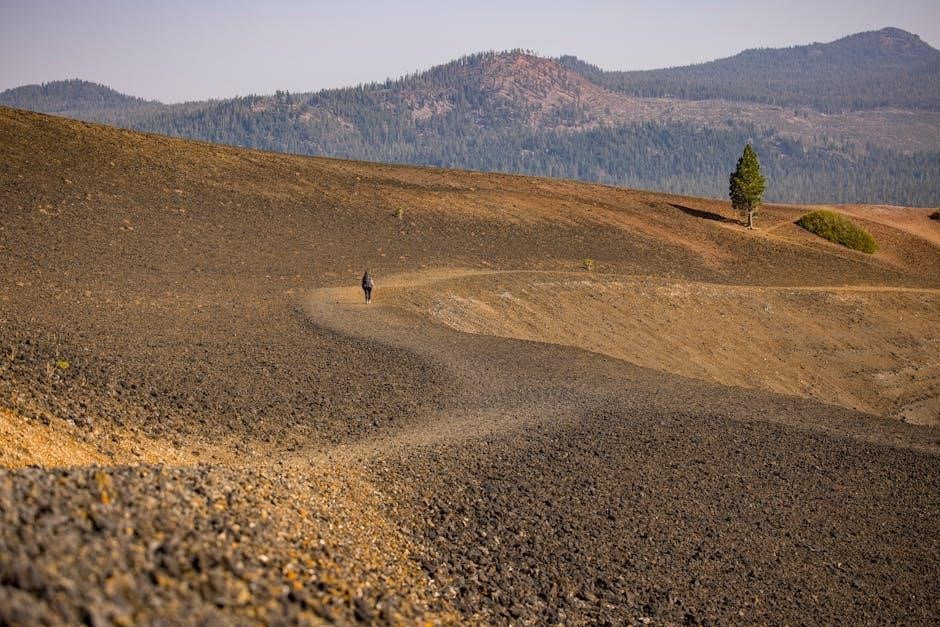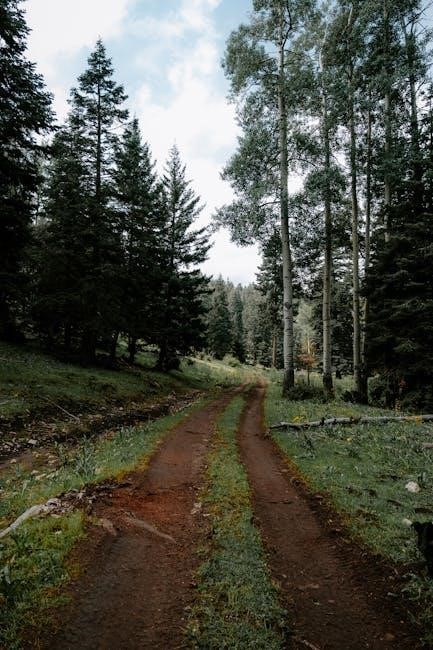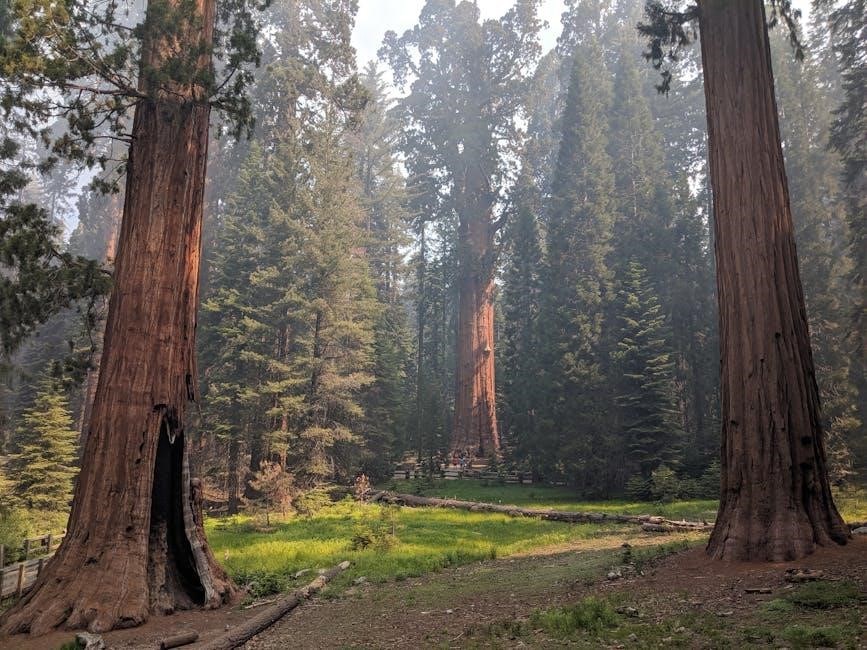Custer State Park, spanning 71,000 acres in South Dakota’s Black Hills, is a sanctuary of natural beauty, offering diverse wildlife, scenic trails, and year-round adventures for all.
1.1 Overview of the Park
Custer State Park, nestled in the Black Hills of South Dakota, offers a diverse landscape of granite peaks, rolling hills, and pristine lakes. With over 71,000 acres, it provides abundant opportunities for outdoor adventures, including hiking, biking, fishing, and wildlife viewing. The park is renowned for its scenic drives, such as the Wildlife Loop Road, where visitors can spot bison, elk, and deer. Its trails range from easy strolls to challenging climbs, making it a paradise for nature lovers and photographers seeking unforgettable experiences in the heart of South Dakota’s wilderness.
1.2 Location and Geography
Custer State Park is situated in the Black Hills of South Dakota, covering 71,000 acres of diverse terrain. The park features granite peaks, dense forests, rolling meadows, and sparkling lakes, creating a varied landscape for exploration; Elevation ranges from 3,700 to 7,244 feet at Black Elk Peak, the highest point in the region. The park’s geography supports abundant wildlife and offers scenic vistas, making it a must-visit destination for outdoor enthusiasts and nature lovers seeking to immerse themselves in South Dakota’s natural beauty.
1.3 Brief History of the Park
Custer State Park, established in 1912 and named after George Armstrong Custer, is nestled within South Dakota’s Black Hills. This region holds deep cultural and historical significance, particularly for Native American communities. The park’s development was influenced by the Civilian Conservation Corps in the 1930s, which built many of its trails and structures. Today, it is renowned for its stunning landscapes, abundant wildlife, and rich heritage, attracting visitors seeking both adventure and a connection to history.
Popular Hiking Trails in Custer State Park
Custer State Park offers iconic trails like Black Elk Peak, Sunday Gulch, and Sylvan Lake Shore, each providing unique landscapes and unforgettable hiking experiences for all skill levels.
2.1 Black Elk Peak Trail
Black Elk Peak Trail is a standout highlight in Custer State Park, offering a moderately challenging 7-mile round-trip hike. The trail features a steep climb, followed by a descent, showcasing breathtaking panoramic views from the summit. Known for its mix of forested paths and open meadows, it attracts hikers seeking both adventure and tranquility. The trail’s diverse terrain and scenic overlooks make it a must-do for outdoor enthusiasts. It also holds historical significance as a spiritual site for Native American tribes, adding depth to the hiking experience.
2.2 Sunday Gulch Trail
Sunday Gulch Trail is a 2.8-mile loop near Sylvan Lake, offering a picturesque hike through forests and along creeks. The trail features diverse terrain, including boulders and scenic overlooks, making it a favorite among visitors. Known for its natural beauty, Sunday Gulch Trail provides a moderate challenge with its uneven paths and elevation changes. Hikers can expect to spend about 2-3 hours exploring this loop, which offers stunning views and immersive nature experiences, making it a must-visit for outdoor enthusiasts in Custer State Park.
2.3 Sylvan Lake Shore Trail
The Sylvan Lake Shore Trail is a 1-mile loop that offers a serene and family-friendly hiking experience around the picturesque Sylvan Lake. This trail is relatively flat, making it accessible for hikers of all skill levels. Surrounded by towering pines and granite formations, the path provides stunning views of the lake and its reflections. It’s a perfect spot for photography, picnics, or simply enjoying nature. The trail is also popular for its peaceful atmosphere, making it an ideal choice for those seeking a relaxing outdoor experience in Custer State Park.

Trail Preparation and Safety
Prepare with water, snacks, a map, and first aid. Check trail conditions and weather forecasts. Stay on marked trails to ensure safety and respect wildlife habitats.
3.1 Essential Items to Bring
Always pack essentials like water, snacks, a map, and a first-aid kit. Bring extra clothing, sturdy footwear, and sun protection. Carry a multi-tool or pocket knife, and ensure your phone is fully charged. A portable charger and navigation tools like a compass or GPS device are recommended. Don’t forget binoculars for wildlife viewing and a flashlight for unexpected delays. Check trail conditions beforehand and inform someone of your itinerary. Proper preparation ensures a safe and enjoyable hiking experience in Custer State Park.
3.2 Safety Tips for Hikers
Hiking in Custer State Park requires attention to safety. Always check trail conditions and inform someone of your itinerary. Stay on marked trails and be aware of your surroundings. Keep a safe distance from wildlife, especially bison, and avoid approaching them. Carry a map and know how to use it. Stay hydrated, watch for changing weather, and be prepared for unpredictable conditions. Keep children close and ensure they understand trail etiquette. Stay alert on scenic drives and never hike alone at night. Respect the park’s natural environment to ensure a safe and enjoyable experience.
3.4 Understanding Trail Difficulty Levels
Custer State Park trails are categorized into easy, moderate, and strenuous levels. Easy trails, like the Sylvan Lake Shore Trail, are short and flat, suitable for families. Moderate trails, such as Sunday Gulch, involve uneven terrain and elevation changes. Strenuous trails, like Black Elk Peak, require physical fitness and endurance due to steep climbs. Always assess your fitness level and choose trails appropriately to ensure a safe and enjoyable hiking experience.

Wildlife Viewing in Custer State Park
Custer State Park offers abundant wildlife viewing opportunities, featuring bison, elk, and deer. Keep a safe distance and enjoy these majestic creatures responsibly.
4.1 Best Practices for Wildlife Viewing
For a safe and enjoyable wildlife viewing experience, maintain a safe distance from animals. Stay in your vehicle and avoid feeding wildlife to ensure their well-being and your safety. Keep noise levels low to avoid startling animals, and never approach or touch them. Be patient and observant, as wildlife can appear unexpectedly. Respect their natural habitat and follow park guidelines to preserve the park’s ecosystem. This responsible approach ensures both visitors and wildlife thrive in Custer State Park’s breathtaking environment.
4.2 Common Wildlife Species
Custer State Park is renowned for its abundant and diverse wildlife. Visitors often spot bison, elk, white-tailed deer, and mountain goats roaming freely. Bighorn sheep and coyotes are also common sightings. Prairie dogs are a favorite among visitors, while birdwatchers can observe species like eagles and hawks. The park’s 71,000 acres provide a natural habitat for these animals, making it a premier destination for wildlife enthusiasts. Exploring the Wildlife Loop Road offers a unique opportunity to encounter these species in their natural environment, creating unforgettable experiences for all who visit.
4.3 Bison Safety Guidelines
When encountering bison in Custer State Park, maintain a safe distance of at least 150 feet. Never approach or feed these wild animals, as they can be unpredictable and dangerous. Keep children close and ensure they understand the importance of staying away. If a bison charges, seek shelter behind a large object or stay in your vehicle. Remember, bison are wild animals and deserve respect. Follow park guidelines and warnings to ensure a safe and enjoyable experience for both visitors and wildlife.

Scenic Drives in Custer State Park
Explore breathtaking vistas on Wildlife Loop Road, marvel at Needles Highway’s towering rock formations, and enjoy panoramic views at scenic overlooks, perfect for photography and relaxation.
5.1 Wildlife Loop Road
Wildlife Loop Road is an 18-mile scenic drive offering unforgettable encounters with Custer State Park’s abundant wildlife. Home to over 1,300 free-roaming bison, the loop also features elk, deer, and prairie dogs. Visitors often spot wildlife grazing or crossing the road, creating memorable moments. Drive slowly, keep a safe distance, and enjoy the natural beauty. Perfect for photography and wildlife enthusiasts, the loop provides an immersive experience. Stop at pullouts for better views or to simply absorb the serene surroundings. This drive is a must-do for anyone exploring the park.
5.2 Needles Highway
Needles Highway is a breathtaking 14-mile scenic drive through Custer State Park, known for its stunning rock formations and narrow tunnels. Part of the Peter Norbeck National Scenic Byway, the road winds past towering granite spires and offers panoramic views of the surrounding hills. The iconic “Needles Eye” tunnel is a highlight, carved through a narrow rock formation. This drive is popular among motorists and motorcyclists, though its narrow passages can challenge larger vehicles. Stop at overlooks to absorb the natural beauty and explore nearby hiking trails or picnic areas.
5.3 Scenic Overlooks and Pullouts
Custer State Park offers numerous scenic overlooks and pullouts, perfect for soaking in the natural beauty of the Black Hills. These designated areas provide stunning views of rolling hills, granite formations, and vast meadows. Ideal for photography, they allow visitors to capture the park’s iconic landscapes. Many pullouts are located along the Wildlife Loop Road and Needles Highway, offering moments to relax and immerse yourself in the surroundings. Remember to bring binoculars for wildlife spotting and take your time to enjoy the serene atmosphere.
Camping and Accommodation Options
Custer State Park offers various camping and lodging options, from cozy campgrounds to scenic cabins, ensuring a comfortable stay amidst nature’s beauty and wildlife.
6.1 Campgrounds Within the Park
Custer State Park offers several campgrounds, each providing a unique camping experience. From primitive sites nestled in the woods to developed areas with amenities, campers can choose options that suit their preferences. Many campgrounds are situated near scenic hiking trails, lakes, and wildlife viewing areas, allowing visitors to immerse themselves in nature. Amenities vary by site, but most provide basic necessities like restrooms and potable water, ensuring a comfortable stay. Whether you’re tent camping or in an RV, the park’s campgrounds offer a perfect base for exploring its natural beauty.
6.2 Lodging and Cabins
Custer State Park offers a variety of lodging options, including cozy cabins and historic lodges, perfect for those seeking comfort amidst nature. Cabins range from rustic charm to well-equipped units with modern amenities, catering to different preferences. Many are situated near scenic overlooks, trails, and wildlife areas, providing easy access to outdoor adventures. These accommodations offer a blend of privacy and convenience, allowing visitors to unwind after a day of exploring the park’s trails and attractions. Staying in the park’s lodging enhances the overall experience, connecting guests to the natural beauty of the Black Hills.
6.3 Backcountry Camping Regulations
Backcountry camping in Custer State Park requires adherence to specific regulations to protect the environment and wildlife. Permits are mandatory and must be obtained in advance. Campsites are designated to minimize ecological impact, and campers are expected to pack out all waste. Campfires are restricted to designated areas and may be prohibited during dry seasons; Visitors must stay on marked trails and maintain a safe distance from wildlife. Respecting these rules ensures the preservation of the park’s natural beauty for future generations. Proper planning and compliance are essential for a safe and enjoyable backcountry experience.

Other Activities in Custer State Park
Custer State Park offers diverse activities beyond hiking, including fishing, boating, and biking. Picnic areas and scenic overlooks provide perfect spots to relax and enjoy nature;
7.1 Fishing and Boating
Fishing and boating are popular activities in Custer State Park, with its pristine lakes and streams offering trout fishing. Sylvan Lake and Stockade Lake are favorites for anglers, while boating enthusiasts enjoy serene waters. A South Dakota fishing license is required. The park’s clear waters and scenic surroundings make these activities a perfect way to unwind and connect with nature.
7.2 Biking Trails
Custer State Park offers an array of biking trails catering to all skill levels, from gentle paved paths to challenging mountain routes. Cyclists can explore rolling hills, dense forests, and scenic overlooks. Families can enjoy leisurely rides on easier trails, while experienced riders can tackle more rugged terrain. Biking is a great way to immerse yourself in the park’s natural beauty and wildlife. Remember to bring water, a map, and adhere to trail regulations to preserve the environment and ensure a safe, enjoyable experience.
7.3 Picnic Areas and Scenic Spots
Custer State Park boasts numerous picnic areas and scenic spots, perfect for relaxing and soaking in the natural beauty. Many picnic areas are located near lakes, forests, and open meadows, offering stunning views. Visitors can enjoy a peaceful meal while surrounded by wildlife and scenic vistas. Remember to bring supplies, as services may be limited. Popular spots include areas near Sylvan Lake and overlooks along the Wildlife Loop Road. These spots provide ideal opportunities to unwind and connect with nature, making them a must-visit for every park enthusiast.

Seasonal Considerations
Custer State Park offers unique experiences year-round, with summer hiking, winter sports, and scenic drives in fall and spring, each season providing unforgettable adventures and views.
8.1 Best Time to Visit
The best time to visit Custer State Park is during summer (June–August) for optimal hiking and wildlife viewing. Spring (April–May) and fall (September–October) offer mild temperatures and fewer crowds, perfect for scenic drives. Winter (December–February) provides serene landscapes and opportunities for cross-country skiing or snowshoeing. Plan your trip according to your preferred activities, whether hiking iconic trails like Black Elk Peak or enjoying peaceful winter explorations.
8.2 Winter Activities
Winter transforms Custer State Park into a serene wonderland, offering unique activities like cross-country skiing, snowshoeing, and winter hiking. The park’s trails, such as the Black Elk Peak Trail, provide peaceful landscapes blanketed in snow. Wildlife viewing remains popular, with bison and deer often seen against the frosty backdrop. Visitors can also enjoy scenic drives on snow-covered roads or explore the park’s tranquil lakes and forests. Plan your visit with warm gear and check trail conditions for a memorable winter adventure in this South Dakota gem.
8.3 Summer Hiking Tips
Summer hiking in Custer State Park offers breathtaking views, but preparation is key. Start early to avoid midday heat and bring ample water and sunscreen. Trails like Black Elk Peak and Sunday Gulch are popular, with diverse terrain and scenic overlooks. Wear sturdy footwear and stay alert for wildlife. Check trail conditions before heading out, as some paths may be closed due to weather. Carry a map and snacks, and enjoy the vibrant wildflowers and cool mountain breezes. Respect the park’s natural beauty and follow all safety guidelines.
Visitor Services and Amenities
Custer State Park offers a visitor center, ranger programs, and guided tours, ensuring a well-informed and enjoyable experience for all guests while preserving park rules and safety.
9.1 Visitor Center Information
The Custer State Park Visitor Center provides essential resources, including maps, trail guides, and up-to-date information on park activities, wildlife viewing, and seasonal events. Rangers are available to answer questions and offer insights to enhance your visit. The center also features exhibits showcasing the park’s natural and cultural history. It’s a great starting point for planning your day, ensuring you make the most of your time exploring the park’s diverse landscapes and attractions.
9.2 Ranger Programs and Guided Tours
Custer State Park offers a variety of ranger-led programs and guided tours, providing insights into the park’s natural and cultural heritage. From educational hikes to wildlife viewing tours, these programs are designed to enhance your understanding and appreciation of the park. Rangers share expert knowledge on topics such as trail history, local flora, and fauna. Guided tours often include scenic drives, nature walks, and interpretive talks. Check the park’s schedule for program times and availability, as some tours may require advance booking.
9.3 Park Rules and Regulations
To ensure a safe and enjoyable experience for all visitors, Custer State Park has established specific rules and regulations. These include staying on designated trails, not feeding wildlife, and carrying proper identification. Visitors must also adhere to trail closures and follow guidelines for camping and picnicking. Littering is prohibited, and guests are encouraged to leave the park in its natural state. Additionally, quiet hours must be respected, and pets should be kept on leashes. Check with the visitor center for detailed information on all park rules to help preserve this natural wonder.